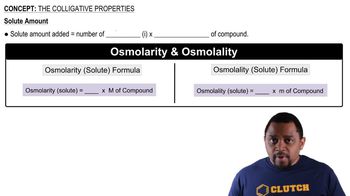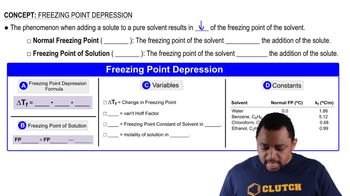Here are the essential concepts you must grasp in order to answer the question correctly.
Colligative Properties
Colligative properties are physical properties of solutions that depend on the number of solute particles in a given amount of solvent, rather than the identity of the solute. These properties include boiling point elevation, freezing point depression, vapor pressure lowering, and osmotic pressure. In this context, the freezing point depression of the solutions is influenced by the number of particles produced when the solute dissolves.
Recommended video:
Dissociation of Electrolytes
Electrolytes are substances that dissociate into ions when dissolved in water. Hydrogen fluoride (HF) is a weak acid and only partially dissociates into H⁺ and F⁻ ions, resulting in fewer particles in solution compared to hydrogen chloride (HCl), which is a strong acid that fully dissociates into H⁺ and Cl⁻ ions. The degree of dissociation directly affects the colligative properties, such as freezing point depression.
Recommended video:
Strong Acid Dissociation Example
Freezing Point Depression
Freezing point depression is a colligative property that describes the lowering of the freezing point of a solvent when a solute is added. The extent of freezing point depression can be calculated using the formula ΔTf = i * Kf * m, where ΔTf is the change in freezing point, i is the van 't Hoff factor (number of particles the solute dissociates into), Kf is the freezing point depression constant, and m is the molality of the solution. The greater the number of solute particles, the lower the freezing point.
Recommended video:
Freezing Point Depression
 Verified step by step guidance
Verified step by step guidance

